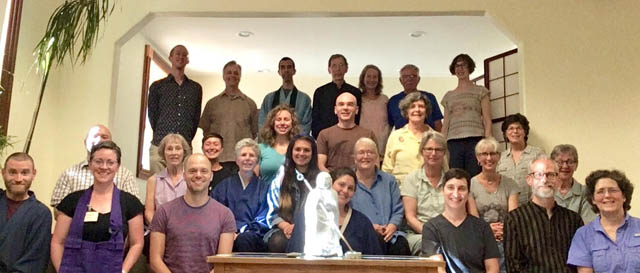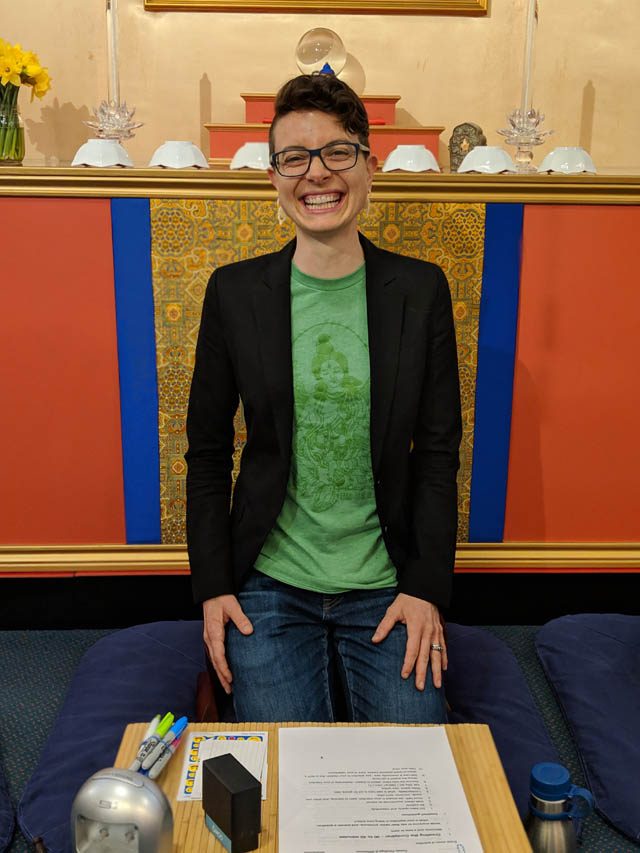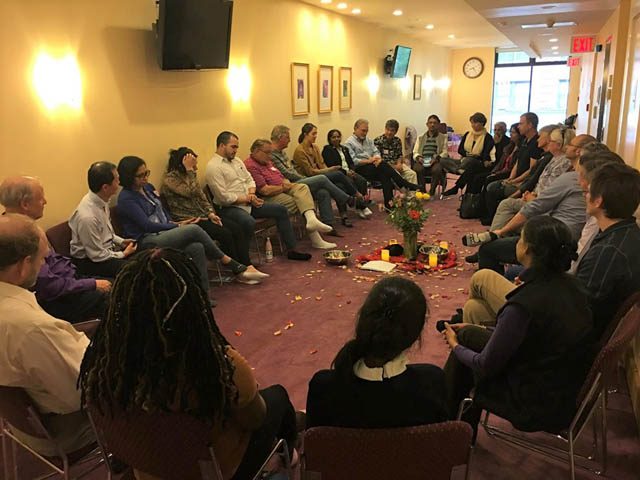Strengthening Diversity and Inclusion on the Path
Written by: Kaitlyn Hatch

People attending the 2017 “Awakening to Whiteness” class, held at the Heart of Wisdom Zen Temple in Portland.
Gender Reconciliation International Website, Laura Humpf, Seattle Shambhala Website, Gretchen Wagner
Reflecting growing awareness of the need for the diversity and inclusion in the dharma, a friend and I developed a series of workshops called “Power, Privilege & Difference: How Buddhist Practice is the Work of Social Restoration.”
Most recently in April I led one of these workshops at the Portland Shambhala Center, and Through July, August and September I will be leading new versions on July 13 and August 24 as part of the NWDharma Presents: Mindfulness and Relationships unconference series.
My colleague in developing these workshops is my spiritual friend John Tsungme Guy, a graduate of Naropa University and a therapist in Seattle.

Guy is trained as a facilitator with Gender Equity & Reconciliation International, an organization that works with men to help them understand the impact of patriarchy, misogyny and sexism on folks of other genders. We developed the format for the “Power, Privilege & Difference: How Buddhist Practice is the Work of Social Restoration” workshops, using our personal and professional experience as well as our spiritual practice.
The very first was in September 2018 at the Seattle Shambhala Center, thanks to then-Director Michael Busby’s support, followed by two others through October and November.
With each presentation the workshops change, but the general structure remains the same.
We start with establishing agreements for the three hours we will be together, be it a group of five or a group of 10.

Then I introduce the practice we will work with that day; be it bodhicitta, metta or tonglen. Bodhicitta is committing oneself to awakening for the sake of all sentient beings, metta is loving-kindness, and tonglen is a way to work with difficult or challenging experiences.
From these we move into an activity called “access and barriers,” intended to help us see the multiplicity of being human, and to cut through dualistic thinking that might try to draw lines as to who is oppressed and who is oppressor.
Following a discussion after this activity participants are partnered up, and we do a guided meditation together. This then leads to dyads, a dharma exercise involving two people talking and listening from the heart.
During the most recent class in Portland the focus was on bodhicitta, and how touching in with it helps us to remain open-hearted and free from dualistic thinking.

Participants have an opportunity to practice formally for a few minutes, but the entire workshop is an opportunity to work with this practice. This is a key element to this work—the technique is important, but the technique is not the practice. The practice is how we take this work out into our lives, and apply it in our day-to-day experience.
In addition to the Power, Privilege & Difference workshops, I’ve also co-facilitated a two-part discussion group called “Illuminating Whiteness,” and organized a small caucus gathering of fellow practitioners to work through Layla Saad’s “Me & White Supremacy”, which is now being published as a book.
Diversity and inclusion are buzzwords these days. Companies are realizing there’s a business case for having a more representative workforce, and the political landscape is beginning to reflect the multiplicity of humanity. The internet exposes us to different voices and experiences, and global movements for social change mean more communities are looking at who is at the table and who isn’t, including dharma communities.

Since 2008 I have participated in many different Buddhist practice spaces: Triratna, Nalandhabodhi, Manghala Shri Buhti. I have had the most continuous connection with Shambhala, but recently, as a Buddhist chaplaincy student I have begun to practice at the Upaya Zen Center. In each of these centers —throughout the United Kingdom, Canada and the United States—the sanghas are predominantly white. This raises a lot of questions for me, given that the primary message of Buddhism is one of collective social liberation.
We are told that the Buddha set out to understand suffering and how to alleviate it for the sake of all beings—not just for himself or his family or his kingdom, people like him. He wanted to attain liberation from the root of suffering for everyone’s benefit. And after he awakened under the bodhi tree he did not hesitate to share what he had learned with anyone he encountered, regardless of caste, gender or age.
This is the lineage from which all modern dharma communities extend, and so exploring the barriers to a diverse and inclusive sangha is imperative. This is especially true for communities dominated by white people with a colonial ancestry based on the enslavement of Black folk, and the displacement and genocide of indigenous peoples.

As with any big project, it’s important to break down our approach and come at it from many angles. Racism is a multi-faceted beast—overwhelmingly so—which illustrates the complexity of our interrelated universe. Thankfully, as dharma practitioners, we have many tools to help us navigate the complex systems that exist to oppress, in which we are all operating and therefore, all subject and all complicit.
My own first step was to raise my awareness of my complicity in white supremacy. As I used shamatha practice to bring awareness to implicit biases I carry as a result of being raised in the white-dominant, colonial society of Canada, I began to see how practices like bodhicitta, metta, and tonglen are incredibly effective for this work.
Of course, I am not the only one offering guidance and helping to create containers for white practitioners to do anti-racism work. In December 2018, several organizations came together to bring Reverend angel Kyodo williams to Seattle for a radical dharma circle weekend, which was incredibly well attended.
During this event I met Laura Humpf, who leads a regular bodywork class called “Undoing Whiteness.” This is intended to acclimatize white socialized folks to the physical discomfort that comes of confronting white fragility, white privilege and white silence. Another leader is Laura Martin, who helped organize the six-month curriculum ”Waking Up To Whiteness: Using the Dharma to Dismantle Oppression,” offered at The Heart of Wisdom Zen Temple in Portland.
These are just a handful of the steps dharma practitioners are taking, to start shifting our practice communities’ cultures to be more inclusive and welcoming. It’s clear there is a growing demand to create intentional practice spaces for looking deeply at the barriers we create, whether intentional or not, again full participation of Black/Indigenous/People of Color practitioners (BIPoC).
This is a need that I am aiming to meet as often as possible. My intention is to create spaces in which anyone, regardless of embodiment, feels seen, heard and represented when they walk through the door.
Kaitlyn Hatch is a writer, artist, podcast producer, philosopher, and designer, and has been a dharma practitioner since 2008. She is queer, non-binary, and disabled, and has Métis and British ancestry. She has most often practiced with Shambhala and in the Kagyu and Nyingma lineages of Tibetan Buddhism, although she considered herself a ‘rogue practitioner.’ Her primary teacher is Pema Chödrön, and she is currently enrolled as a student in the Upaya Zen Center’s Buddhist chaplaincy training.
